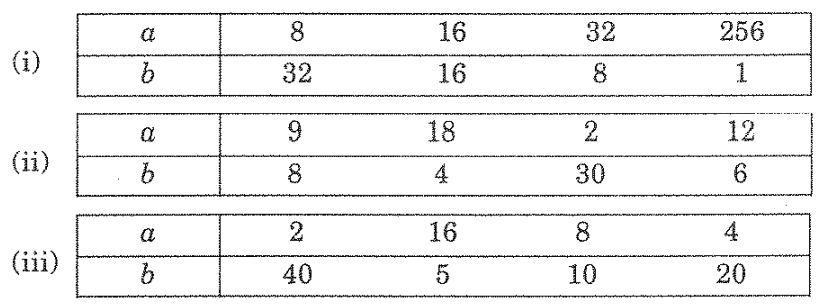In which of the following tables, a and b vary directly. Also, find the constant of variation if a and b are in direct variation. (i) a, 4, 7, 21, 28 b, 12, 21, 63, 84 (ii) a, 2.5, 5, 7.5, 10, 15 b, 10, 20, 30, 40, 60 (iii) a, 1, 2, 3, 4, 5 b, 2, 1, 6, 3, 2/5
(i) Table is in direct variation.
Constant of variation is 3.
(ii) Table is in direct variation.
Constant of variation is 4.
(iii) The table is not in direct variation.
Topper's Solved these Questions
Similar Questions
Knowledge Check
The mode of the data −3,4,0,4,−2,−5,1,7,10,5 is :
A. 0
B. 4
C. -2
D. 7ACBACBDDIf A = {1, 3, 9, 10, 21), B= {4, 6, 8, 10} and C = {1, 2, 3, 4, 5, 6, 7, 8, 9, 10}, then the value of A∩(B∩C) is
A{8, 10}B{10}CNone of theseD{2, 10}
In which of the following tables a and b vary inversely:

View SolutionShow that the following points are collinear:
(i) A(2, -2), B(-3, 8) and C(-1, 4)
(ii) A(-5, 1), B(5, 5) and C(10, 7)
(iii) A(5, 1), B(1, -1) and C(11, 4)
(iv) A(8, 1), B(3, -4) and C(2, -5)
View SolutionConsider the following table of inverse variation: M 1 -6 2 C N -4 A B 60 The values of A, B and C in the above table respectively are −1, −30, 10 b. −30, 10, −1 c. 10, −30, −1 d. 10, −1, 30
View SolutionWhich of the following relations are functions? Give reasons. If it is a function, determine its domain and range:
(i) {(2,1), (3,1),(4,2)}
(ii) {(2,2),(2,4),(3,3),(4,4)}
(iii) {(2,1),(5,1),(8,1),(11,2),(14,2),(17,2)}
(iv) {(1,2),(2,3),(3,4),(4,5),(5,6),(6,7)}
(v){(2,1),(4,2),(6,3),(8,4),(10,5)}
(vi) {(1,2),(2,3),(3,4),(3,5),(3,7),(4,8)}
View SolutionFind the direction cosines of the line joining the following points :
(i) A(2,−1,3),B(3,1.1)
( ii) A(2,−1,2),B(−4,2,0)
(iii) A(4,3,−5),B(−2,1,−8)
View SolutionWhich of the following relations are functions? Give reasons. If it is a function, determine its domain and range.
(i) {(2,1),(5,1),(8,1),(11,1),(14,1),(17,1)}
(ii) {(2,1),(4,2),(6,3),(8,4),(10,5),(12,6),(14,7)}
(iii) {(1,3),(1,5),(2,5)}
View Solution

